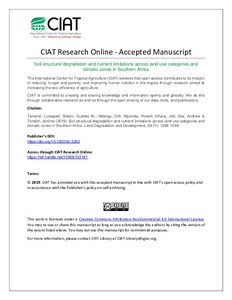Soil structural degradation and nutrient limitations across land use categories and climatic zones in Southern Africa
Although soil degradation is a major threat to food security and carbon sequestration, our knowledge of the spatial extent of the problem and its drivers is very limited in Southern Africa. Therefore, this study aimed to quantify the risk of soil structural degradation and determine the variation in soil stoichiometry and nutrient limitations with land use categories (LUCs) and climatic zones. Using data on soil clay, silt, organic carbon (SOC), total nitrogen (N), available phosphorus (P), and sulfur (S) concentrations collected from 4,468 plots on 29 sites across Angola, Botswana, Malawi, Mozambique, Zambia and Zimbabwe, this study presents novel insights into the variations in soil structural degradation and nutrient limitations. The analysis revealed strikingly consistent stoichiometric coupling of total N, P, and S concentrations with SOC across LUCs. The only exception was on crop land where available P was decoupled from SOC. Across sample plots, the probability (�?) of severe soil structural degradation was 0.52. The probability of SOC concentrations falling below the critical value of 1.5% was 0.49. The probabilities of soil total N, available P, and S concentrations falling below their critical values were 0.95, 0.70, and 0.83, respectively. N limitation occurred with greater probability in woodland (�? = .99) and forestland (�? = .97) than in cropland (�? = .92) and grassland (�? = .90) soils. It is concluded that soil structural degradation, low SOC concentrations, and N and S limitations are widespread across Southern Africa. Therefore, significant changes in policies and practices in land management are needed to reverse the rate of soil structural degradation and increase soil carbon storage

